Baten, Blum, and a Bevy of Bids
August 16th, 2015
|
The Colchester, Connecticut, cherry block- and shell-carved chest-on-chest, 74" high and 40¼" wide, attributed to Samuel Loomis (1770-1800), sold for $408,000 to Colchester, Connecticut, dealer Arthur Liverant of Nathan Liverant and Son, who held his cell phone to his ear, underbid by a telephone bidder. The price was a good one. Called a “Masterpiece” in Albert Sack’s The New Fine Points of Furniture: Early American, the chest-on-chest had been on the market privately with a much higher price tag. Liverant said he heard Selma Blum had a standing $1,000,000 price for it.
The pair of circa 1815 Regency papier-mâché wine coasters, each 5¼" diameter and gilt-decorated with peafowl and scalloped-edge borders, was estimated at $200/400 but sold for $4080 to dealer Chris Jussel, who said the red-lacquered color made them rare. “I’ve been doing this for forty years, and I’ve never seen another red pair,” he said.
Here’s a charming pair of watercolor and pencil portraits of a young boy and girl; she’s holding berries, and he’s holding a book. Each is 21¾" x 17" (sight). They sold for $20,400 (est. $7000/10,000) to dealer Arthur Liverant. Blum.
“Big Bubba.” That’s what Jonathan Rickard, collector and author of Mocha and Related Dipped Wares, 1770-1939, called the “dipped fan” mocha jug that is 9½" high. It sold for $26,400 to a phone bidder on the line with Northeast’s James Horan. It’s been through auctions twice before. On October 27, 1989, Rickard bought it at Skinner for $6600. When he sold it at Skinner on October 28, 2001, it sold to dealer Jonathan Trace for $50,600. “I’d always ask Selma if she knew where it was, and she would always say no,” Rickard said, “It turns out it was in her personal collection.” Blum.
Everybody liked it, but Gardiner, Maine, dealer Nathan Tuttle, sitting with Linda Bean, granddaughter of L.L. Bean and owner of Linda Bean’s Perfect Maine, paid $38,400 (est. $8000/12,000) for the New England painted oval-top tavern table with smoke decoration, probably added in the 1860s. It stands 26" high, and the oval top measures 30½" x 24". Some thought the table was Rhode Island, while others thought the brackets pointed to a Massachusetts origin. Blum. |
Northeast Auctions, Portsmouth, New Hampshire
Photos courtesy Northeast Auctions
“What is this, a sale from twenty-five years ago?” asked one dealer midway through Northeast Auctions’ August 14-16 sale in Portsmouth, New Hampshire. “When’s the last time you saw so much of this stuff sell?”
He was right. When the arc of the history of the antiques business is written, Ron Bourgeault’s three-day sale may represent a landmark sale. Not because prices were record-breaking high or because multiple million-dollar pieces were sold, but rather because all three days showed real strength in the antiques market.
Consider the opening session of the sale, which consisted of 277 lots of brass, delft, stoneware, mocha, and English ceramics, much of it from the stock of Mr. and Mrs. Jerome Blum. Lot after lot sold—to bidders in house, on the phones, and via the Internet—with only three passed lots. With such an opening act, in collecting fields that are pretty narrow, it became obvious that Northeast Auctions would have a good three days.
Expectations were high. After all, the sale included the collections of Mickey and Jill Baten, collectors who treaded in the upper echelon of the Americana business, and of Mr. and Mrs. Jerome Blum, longtime and well-respected dealers and collectors. Well into his 90s, Jerome passed away on December 24, 1998. Selma continued the business for years, until May 2015. Now she has moved to assisted living housing in northern Virginia.
The second day opened with 29 lots of American furniture from the Baten collection. Only one lot from that group was passed, a poplar architectural dower chest, probably Pennsylvania, estimated at $6000/8000. The top Baten price was $105,000 (includes buyer’s premium), paid by a phone bidder for four Chippendale side chairs, 1765-70, attributed to Thomas Tufft of Philadelphia. The set was underbid by an absentee bid. The chairs were well known. Two were published in Volume VII of American Antiques from Israel Sack Collection in 1983 along with a 19th-century photograph of the chairs in the Smith-Marsh family home. The other two appeared in American Antique Furniture by Edgar Miller and in Bernard & S. Dean Levy’s Gallery Catalogue IX, published in 1997.
Coming in at number two from the Baten collection was a mahogany block-front slant-lid desk, attributed to the shop of cabinetmaker Nathaniel Gould of Salem, Massachusetts. Its provenance is ex-Sack, and called “Best” by Sack in Fine Points of Furniture: Early American, and ex-Levy. It brought $91,200 (est. $30,000/50,000) from dealer Roberto Freitas of Stonington, Connecticut, underbid by a phone bidder.
The Baten consignment brought in a cool $663,780.
Following the Batens’ collection, the Blums’ personal collection was brought to the block, approximately 485 lots in their own catalog. There was no question what the top lot was going to be—a three-shell cherry blockfront chest-on-chest, attributed to cabinetmaker Samuel Loomis of Colchester, Connecticut. Estimated at $200,000/400,000, it sold to Colchester, Connecticut, dealer Arthur Liverant of Nathan Liverant and Son, bidding for a client. The underbidder was on the phone.
Liverant commented that it was a well-known and much-coveted piece. “It is a testament to the originality and creativity of Connecticut cabinetmaking, specifically Samuel Loomis the third,” he said. “They took a lot of their ideas from urban areas, put them together in a melting pot, and came up with some amazing examples of Chippendale and Queen Anne furniture,” said Liverant.
When we spoke several days after the sale, Liverant said the chest-on-chest was in his shop. “The fun part for me is that it is now standing in our shop,” he said, adding that it was now just minutes from where it was made. According to Connecticut Valley Furniture: Eliphalet Chapin and His Contemporaries, 1750-1800 by Thomas P. Kugelman, Alice K. Kugelman, and Robert Lionetti, Loomis advertised his shop as being “two miles and a half south of the meeting house, in Colchester.” The meeting house was the Congregational Church, just four buildings away from the 1835-built Baptist church that now serves as the shop for Nathan Liverant and Son.
Liverant thought the $408,000 price was a good one considering “the level of masterpiece that it is. Albert Sack illustrated it in his book and called it a ‘masterpiece.’ It’s a great example of creativity that was made around 1780. It’s 235 years old and has stood the test of time, not only for construction but for design and artistic merit.” Liverant said he had been prepared to pay much more. “It has such a presence. I couldn’t be more thrilled,” he said.
A phone bidder paid $168,000 for a 1775-1800 cherry bonnet-top highboy from Middletown or Chatham, Connecticut. The underbidder was also on the phone. In 1993 the Blums had related to Jonathan Rickard (M.A.D., September 1993) how they acquired it: “It was advertised by a descendant of the original owners. It was the weekend of the Hartford show, so we couldn’t figure why no one else was beating this guy’s door down. We looked it all over, pulled out all the drawers, turned it upside down and inside out, and it was completely straight. Untouched,” Jerry told Rickard. “He quoted us ‘eighty-five.’ We both thought it was eighty-five hundred.” The price was actually $85,000. The Blums said they knew there was no way they could get any more for it than what they had paid, so it went into the house.
The Blums’ personal collection of mocha was impressive. Jerry Blum had started buying mocha for inspiration while designing sheets, pajamas, and ties when he was vice president in charge of design for United Merchants and Manufacturing. “I didn’t know mocha from schmoka,” he told Rickard in 1993. The top piece of mocha was a large (9½" tall) jug with dipped fans decorating the sides, circa 1810, that sold for $26,400 to a phone bidder on the line with Northeast’s James Horan. That’s a little more than half what it brought ($50,600) when it had sold at Skinner in 2001.
The Blum collection brought in a total of $2,328,510.
Selma’s nephew Stanley M. Knoll said the family was “very pleased with process and the outcome. We’re so happy their antiques meant so much to so many people. It’s a small measure of immortality. We credit Ron, his staff, and Jonathan and Paige Trace for their expertise and remarkable professionalism in working with the family.”
 The three-day sale represented a new strategy for Northeast Auctions. In the past, the firm has held an Americana auction on the weekend before Antiques Week in New Hampshire in Manchester, New Hampshire, and a marine and Chinese export sale later in August. This year, Bourgeault combined them all into one weekend following Antiques Week in New Hampshire, and the results were favorable. In 2014 Northeast Auctions did $1.31 million at the Americana sale in Manchester, and the marine and Chinese export sale brought in another $3.6 million for a total of $4.9 million. This 2015 three-day sale brought $5,142,180—a slightly higher total and also done without the expense of mounting a sale off site in a city 44 miles away from Portsmouth.
The three-day sale represented a new strategy for Northeast Auctions. In the past, the firm has held an Americana auction on the weekend before Antiques Week in New Hampshire in Manchester, New Hampshire, and a marine and Chinese export sale later in August. This year, Bourgeault combined them all into one weekend following Antiques Week in New Hampshire, and the results were favorable. In 2014 Northeast Auctions did $1.31 million at the Americana sale in Manchester, and the marine and Chinese export sale brought in another $3.6 million for a total of $4.9 million. This 2015 three-day sale brought $5,142,180—a slightly higher total and also done without the expense of mounting a sale off site in a city 44 miles away from Portsmouth.
For more information, contact Northeast Auctions at (603) 433-8400 or see the website (www.northeastauctions.com).
|
|
|
|
|
|
|
|
|
|
|
|
|
|
|
|
|
|
|
|
|
|
|
|
|
|
Originally published in the October 2015 issue of Maine Antique Digest. © 2015 Maine Antique Digest




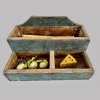



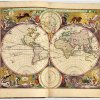





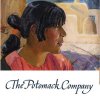














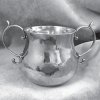






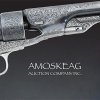


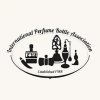


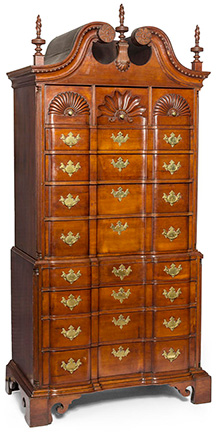
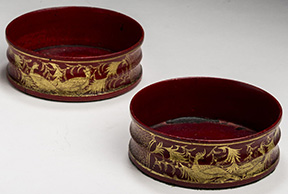
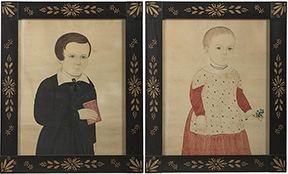
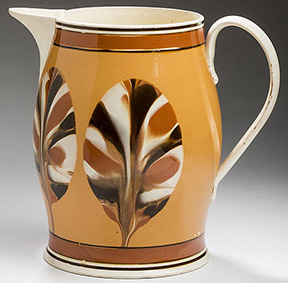
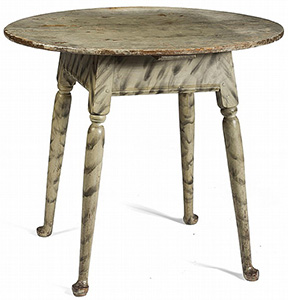
 A phone bidder paid $168,000 for the 1775-1800 cherry bonnet-top highboy made in Middletown or Chatham, Connecticut. The underbidder was also on the phone. The pinwheel carving on both the upper and lower center drawers is deep, and the skirt has cyma curves with C-scrolls at the corners. The chest measures 87¼" tall x 38¼" wide x 19½" deep and is published in Connecticut Valley Furniture: Eliphalet Chapin and His Contemporaries, 1750-1800 (no. 49, p. 119). Blum.
A phone bidder paid $168,000 for the 1775-1800 cherry bonnet-top highboy made in Middletown or Chatham, Connecticut. The underbidder was also on the phone. The pinwheel carving on both the upper and lower center drawers is deep, and the skirt has cyma curves with C-scrolls at the corners. The chest measures 87¼" tall x 38¼" wide x 19½" deep and is published in Connecticut Valley Furniture: Eliphalet Chapin and His Contemporaries, 1750-1800 (no. 49, p. 119). Blum. A phone bidder paid $105,600 for the 1812 Duncan Phyfe worktable, underbid by decorative arts consultant Bill Stahl in the audience. Duncan Phyfe: Master Cabinetmaker in New York notes that Phyfe charged James Kelso (1781-1842) and his wife, Leah Helen Henry Kelso (b. 1786), $52 for the worktable, which has brass molding on the top edge and a base with four fluted spiral columns on a fluted plinth, all added expenses. Blum.
A phone bidder paid $105,600 for the 1812 Duncan Phyfe worktable, underbid by decorative arts consultant Bill Stahl in the audience. Duncan Phyfe: Master Cabinetmaker in New York notes that Phyfe charged James Kelso (1781-1842) and his wife, Leah Helen Henry Kelso (b. 1786), $52 for the worktable, which has brass molding on the top edge and a base with four fluted spiral columns on a fluted plinth, all added expenses. Blum.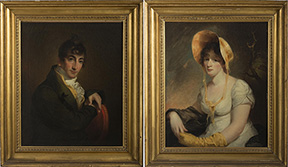 This pair of 29" x 24" portraits by Thomas Sully (1783-1872) sold to a phone bidder for $72,000, well above the $15,000/25,000 estimate. The pair is of Philadelphia merchant Reeve Lewis (1781-1821) and his wife, Rachel Waln Thomas Lewis (1781-1849). According to The Life and Works of Thomas Sully by Edward Biddle and Mantle Fielding, Sully worked on the portraits in the spring of 1808. He started Reeve’s portrait on March 18 and finished it on April 18. He began Rachel’s portrait on April 25 and finished on May 19. Blum.
This pair of 29" x 24" portraits by Thomas Sully (1783-1872) sold to a phone bidder for $72,000, well above the $15,000/25,000 estimate. The pair is of Philadelphia merchant Reeve Lewis (1781-1821) and his wife, Rachel Waln Thomas Lewis (1781-1849). According to The Life and Works of Thomas Sully by Edward Biddle and Mantle Fielding, Sully worked on the portraits in the spring of 1808. He started Reeve’s portrait on March 18 and finished it on April 18. He began Rachel’s portrait on April 25 and finished on May 19. Blum.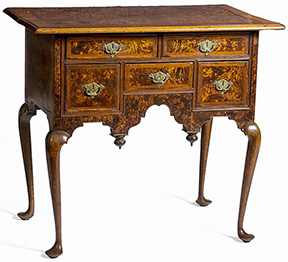 A discovery was made during the preview. Kemble Widmer found that a signature in 18th-century chalk was on the underside of one of the drawers of the 1730-50 inlaid walnut and burl walnut lowboy, probably from the Ipswich, Massachusetts, area. The signature was William Wigglesworth, and it was too soon to determine whether he was an owner or maker. (We have no Wigglesworths in the Maine Antique Digest Cabinetmakers Database.) Measuring 30¾" high, with a case width of 27¾", the lowboy sold to Clark Pearce for $96,000, underbid by Arthur Liverant. Blum.
A discovery was made during the preview. Kemble Widmer found that a signature in 18th-century chalk was on the underside of one of the drawers of the 1730-50 inlaid walnut and burl walnut lowboy, probably from the Ipswich, Massachusetts, area. The signature was William Wigglesworth, and it was too soon to determine whether he was an owner or maker. (We have no Wigglesworths in the Maine Antique Digest Cabinetmakers Database.) Measuring 30¾" high, with a case width of 27¾", the lowboy sold to Clark Pearce for $96,000, underbid by Arthur Liverant. Blum.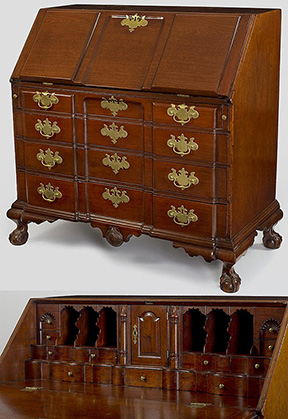 Attributed to the Salem, Massachusetts, shop of Nathaniel Gould, this 1770-81 mahogany drop-front desk with a blocked case and lid, ball-and-claw feet, a complex interior, and original brasses, 44¾" x 41¾" x 24", sold to Roberto Freitas for $91,200, underbid by someone on the phone. The provenance includes Bernard & S. Dean Levy and Israel Sack. Albert Sack called it “Best” in Fine Points of Furniture, Early American, noting that it expressed “the Yankee character of dignity, vigor, and honesty.” Baten.
Attributed to the Salem, Massachusetts, shop of Nathaniel Gould, this 1770-81 mahogany drop-front desk with a blocked case and lid, ball-and-claw feet, a complex interior, and original brasses, 44¾" x 41¾" x 24", sold to Roberto Freitas for $91,200, underbid by someone on the phone. The provenance includes Bernard & S. Dean Levy and Israel Sack. Albert Sack called it “Best” in Fine Points of Furniture, Early American, noting that it expressed “the Yankee character of dignity, vigor, and honesty.” Baten.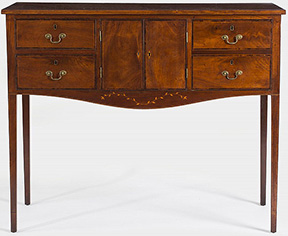 Attributed to Thomas Howard Jr. of Providence, Rhode Island, this small (39¾" x 47 7/8" x 20") circa 1800 mahogany sideboard sold to Arthur Liverant for $30,000, underbid by the phone. It’s going home; it had a Nathan Liverant and Son provenance. Over the years several sideboards by Thomas Howard with varying ornamentation and inlay have sold at auction; the highest price was for one at Christie’s in January 2000 with a Jess Pavey provenance that brought $200,500. For more on Thomas Howard, see The Magazine Antiques article by Eleanore Bradford Monahon in June 1965, pp. 702-04. Baten.
Attributed to Thomas Howard Jr. of Providence, Rhode Island, this small (39¾" x 47 7/8" x 20") circa 1800 mahogany sideboard sold to Arthur Liverant for $30,000, underbid by the phone. It’s going home; it had a Nathan Liverant and Son provenance. Over the years several sideboards by Thomas Howard with varying ornamentation and inlay have sold at auction; the highest price was for one at Christie’s in January 2000 with a Jess Pavey provenance that brought $200,500. For more on Thomas Howard, see The Magazine Antiques article by Eleanore Bradford Monahon in June 1965, pp. 702-04. Baten.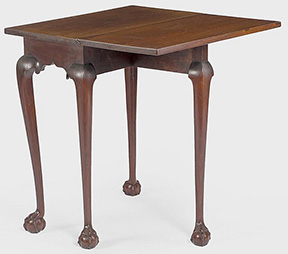 Ex-Sack, this small (26 5/8" x 24½" x 13") single drop-leaf mahogany table with cabriole legs and ball-and-claw feet, Massachusetts, 1760-80, sold to Virginia collectors for $26,400. When Sack published in it Vol. VI, he wrote, “One leaf drop-leaf tables are a rare form predominantly [from]Massachusetts. This is certainly the smallest one known and one of the finest.” Baten.
Ex-Sack, this small (26 5/8" x 24½" x 13") single drop-leaf mahogany table with cabriole legs and ball-and-claw feet, Massachusetts, 1760-80, sold to Virginia collectors for $26,400. When Sack published in it Vol. VI, he wrote, “One leaf drop-leaf tables are a rare form predominantly [from]Massachusetts. This is certainly the smallest one known and one of the finest.” Baten.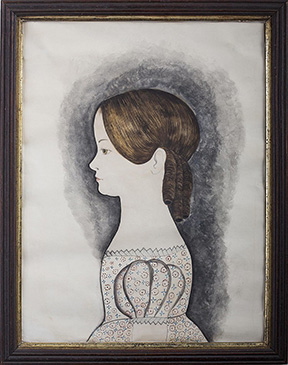 Dealer Peter Eaton gave it a run but a phone bidder was the winner of this portrait by Mary B. Tucker (1784-1853), watercolor and ink on paper, 19" x 14¼", paying $19,200. Eaton did win the next lot (not shown), a Tucker portrait of a young boy in a blue coat for $2400. Works by Tucker are rare and little is known about her life. Blum.
Dealer Peter Eaton gave it a run but a phone bidder was the winner of this portrait by Mary B. Tucker (1784-1853), watercolor and ink on paper, 19" x 14¼", paying $19,200. Eaton did win the next lot (not shown), a Tucker portrait of a young boy in a blue coat for $2400. Works by Tucker are rare and little is known about her life. Blum.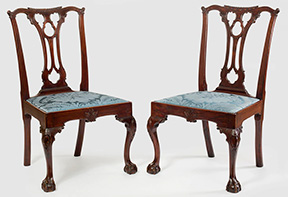 A set of four Chippendale mahogany side chairs (two shown), attributed to Thomas Tufft (c. 1740-1788) of Philadelphia, sold to a phone bidder for $105,000, underbid by an absentee bid. Each circa 1770 chair has an egg-and-dart carved crest with leaf-carved ears, a carved and pierced Gothic trefoil splat, an apron with C-scrolled border with centered acanthus leaves, slender cabriole legs with a cartouche, and ball-and-claw feet. When two of the chairs were published in American Antiques from Israel Sack Collection, Vol. VII, accompanied by a period photograph of them in the home of the Smith Marsh family, it was noted that the crest rail and splat were attributed to James Gillingham but the legs suggested Thomas Tufft. Scholarship has progressed; they are now solidly attributed to Tufft. Baten.
A set of four Chippendale mahogany side chairs (two shown), attributed to Thomas Tufft (c. 1740-1788) of Philadelphia, sold to a phone bidder for $105,000, underbid by an absentee bid. Each circa 1770 chair has an egg-and-dart carved crest with leaf-carved ears, a carved and pierced Gothic trefoil splat, an apron with C-scrolled border with centered acanthus leaves, slender cabriole legs with a cartouche, and ball-and-claw feet. When two of the chairs were published in American Antiques from Israel Sack Collection, Vol. VII, accompanied by a period photograph of them in the home of the Smith Marsh family, it was noted that the crest rail and splat were attributed to James Gillingham but the legs suggested Thomas Tufft. Scholarship has progressed; they are now solidly attributed to Tufft. Baten. A phone bidder paid $132,000 for this circa 1860 China trade scene of the Praya Grande at Macao. The large oil on canvas (32" x 58½") is ex-William Edwin Hall, a corporate lawyer of Greenwich, Connecticut, who in 1944 married Mary Vanderveer Roberts, widow of Owen Roberts, a dealer of Chinese art and antiques. It was also owned by pulp magazine and book publisher Gordon Fawcett of Fawcett Publications. The scene shows the Portuguese flag flying from the Guia Fort, Penha Hill, the U.S. consulate, the cathedral, and the “forty-pillared” house, once the home of the merchant John C. Whiteman, later the French consulate, and in this view, the Duddell Oriental Hotel.
A phone bidder paid $132,000 for this circa 1860 China trade scene of the Praya Grande at Macao. The large oil on canvas (32" x 58½") is ex-William Edwin Hall, a corporate lawyer of Greenwich, Connecticut, who in 1944 married Mary Vanderveer Roberts, widow of Owen Roberts, a dealer of Chinese art and antiques. It was also owned by pulp magazine and book publisher Gordon Fawcett of Fawcett Publications. The scene shows the Portuguese flag flying from the Guia Fort, Penha Hill, the U.S. consulate, the cathedral, and the “forty-pillared” house, once the home of the merchant John C. Whiteman, later the French consulate, and in this view, the Duddell Oriental Hotel.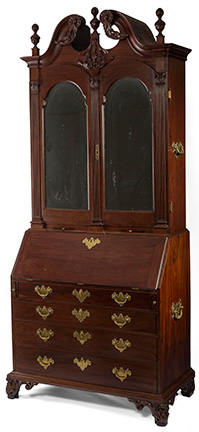 “It’s the most sophisticated piece here,” said one dealer when speaking about a Massachusetts carved mahogany desk-and-bookcase attributed to John Welch of Boston. It was also the most enigmatic. Measuring 92" x 38¾" x 22½", it has a rosetted swan’s-neck crest carved with leafage and three foliated urn-shaped turned finials. The frieze features a flower-filled basket. It has a pair of mirrored arched doors that open to an interior with shell carving, serpentine pigeonholes, and small drawers. The lower section has a slant front and serpentine interior with a block-fronted cupboard door above four long drawers and leaf-carved bracket feet. It was originally cataloged as being the same Welch-attributed desk-and-bookcase illustrated in Frances Clary Morse’s 1917 book Furniture of the Olden Time and discussed in Alan Miller’s 1993 article in Chipstone’s American Furniture (“Roman Gusto in New England: An Eighteenth-Century Boston Furniture Designer and His Shop”). By the time the preview rolled around and a closer inspection was done, it was determined that it was not the same one. It had restoration, which the catalog said John Walton did in the 1950s “with carved elements similar to those on other Boston pieces of the same period.” When it came up for bidding, it opened at $45,000 and was hammered for $50,000 ($60,000 with buyer’s premium) to a phone bidder. It relates directly to other John Welch-attributed pieces, including the John Allen desk-and-bookcase at Winterthur and the Gilbert Deblois family example that sold for $3,288,000 at Sotheby’s in January 2007. Blum.
“It’s the most sophisticated piece here,” said one dealer when speaking about a Massachusetts carved mahogany desk-and-bookcase attributed to John Welch of Boston. It was also the most enigmatic. Measuring 92" x 38¾" x 22½", it has a rosetted swan’s-neck crest carved with leafage and three foliated urn-shaped turned finials. The frieze features a flower-filled basket. It has a pair of mirrored arched doors that open to an interior with shell carving, serpentine pigeonholes, and small drawers. The lower section has a slant front and serpentine interior with a block-fronted cupboard door above four long drawers and leaf-carved bracket feet. It was originally cataloged as being the same Welch-attributed desk-and-bookcase illustrated in Frances Clary Morse’s 1917 book Furniture of the Olden Time and discussed in Alan Miller’s 1993 article in Chipstone’s American Furniture (“Roman Gusto in New England: An Eighteenth-Century Boston Furniture Designer and His Shop”). By the time the preview rolled around and a closer inspection was done, it was determined that it was not the same one. It had restoration, which the catalog said John Walton did in the 1950s “with carved elements similar to those on other Boston pieces of the same period.” When it came up for bidding, it opened at $45,000 and was hammered for $50,000 ($60,000 with buyer’s premium) to a phone bidder. It relates directly to other John Welch-attributed pieces, including the John Allen desk-and-bookcase at Winterthur and the Gilbert Deblois family example that sold for $3,288,000 at Sotheby’s in January 2007. Blum.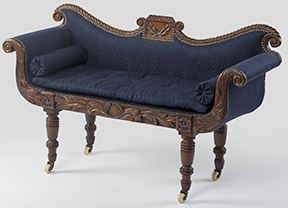 Maryland dealer Rusty Donohue was in the bidding early for the circa 1820 Federal carved New England child-size sofa. At $8500, he jumped the bid to $10,000, but that aggressive tactic didn’t slow the bidding. It kept right on going, all the way to $34,800 from a phone bidder, underbid by another phone. Ex-Samuel Herrup and David A. Schorsch and Eileen M. Smiles, it measures 22¼" x 38" x 13", has an arched crest with leaf-and-scroll carved border centered by a rectangular leaf-carved panel, scrolled arms and seat rail with matching carvings, and turned legs fitted with casters. Baten.
Maryland dealer Rusty Donohue was in the bidding early for the circa 1820 Federal carved New England child-size sofa. At $8500, he jumped the bid to $10,000, but that aggressive tactic didn’t slow the bidding. It kept right on going, all the way to $34,800 from a phone bidder, underbid by another phone. Ex-Samuel Herrup and David A. Schorsch and Eileen M. Smiles, it measures 22¼" x 38" x 13", has an arched crest with leaf-and-scroll carved border centered by a rectangular leaf-carved panel, scrolled arms and seat rail with matching carvings, and turned legs fitted with casters. Baten.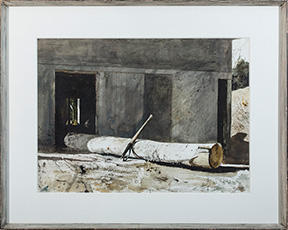 The Peavey by Andrew Wyeth (1917-2009), watercolor on paper, 21½" x 29¾", sold to dealer Nicholas Wyeth, the son of the artist, who paid $156,000. It was fresh; it had never been out of the Cogswell family, who bought it directly from Andrew Wyeth in 1965. An original bill was included in the lot as were handwritten notes by Wyeth including one where he describes it as one of his best watercolors.
The Peavey by Andrew Wyeth (1917-2009), watercolor on paper, 21½" x 29¾", sold to dealer Nicholas Wyeth, the son of the artist, who paid $156,000. It was fresh; it had never been out of the Cogswell family, who bought it directly from Andrew Wyeth in 1965. An original bill was included in the lot as were handwritten notes by Wyeth including one where he describes it as one of his best watercolors.


